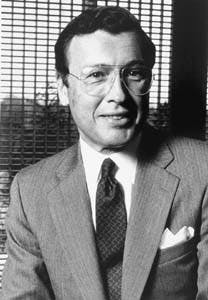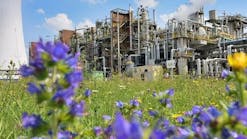Alfred C. Decrane Jr.
Chairman and Chief Executive Officer
Texaco Inc.
White Plains, N.Y.
From an address, Cheaper by the Gallon, to the Executives Club of Chicago.
Perhaps the title of my remarks surprises some of you.
I chose it as a way to focus our attention on how the petroleum industry has met the challenge of keeping the world supplied with clean, affordable, plentiful energyenergy thats cheaper by the gallon.
Today, on the streets of Chicago, a gallon of gasoline, including all taxes, costs about $1.40. Now some of you may feel thats too much. But factoring in inflation, taxes included, the retail price of gasoline in the U.S. is nearly as low as it has ever been since record keeping began in the 1920s.
Its cheaper than it was in the early 1970s before the first Middle East oil embargo, which more than quadrupled the price of crude oil. And its even cheaper than the $2/gal or more we pay for Coca-Cola or the $7/gal for Perrier water.
Oil shock
Think back to that mid-70s period. In the wake of the first Middle East oil embargo, this country was in shock. The embargo cost half a million Americans their jobs, U.S. GNP fell by $50 billion, and Americas sense of security faltered.
At that time, many alleged experts predicted crude oil prices would rise to $50 or $60/bbl and beyond. Others claimed world oil reserves would dry up within 50 years. As they saw it, petroleum couldnt maintain its primacy as the worlds economic, plentiful, fuel of choice.
They were wrong. Thank goodness for experts.
Today:
- Oil and natural gas provide fully 60% of the worlds energy.
- Oil is selling for about $17/bbl.
- Global reserves have been increased by 60% even though worldwide consumption of hydrocarbons has risen 36% during this period.
- With oil consumption at about 70 million b/d, the world still has about a 50 year supply and we continue to add to our reserve base.
Upstream technology
Perhaps our most dramatic achievements have been through the innovative use of advanced technologies. From the drill pipe in our wells to the tail pipe of your vehicles, technology is transforming this business.
For example, in our upstream business we have made fantastic advances in determining where our best chances of success are before we drill. We have reduced the risk of drilling dry holes; and that drives down our costs.
The key has been development and application of 3D seismic imaging. We have long used reflected sound generated by explosives or other sources to give us a 2D view of the earths layers below the surface.
3D seismic, coupled with sophisticated, computer enhanced processing, opens new vistas. Now the resolution is much greater, to the extent that we can see folds and traps in the subsurface that were obscured or hidden by the limits of 2D seismic.
We also are improving our techniques for generating this information. Initially, we could use 3D seismic only in open water or dry, easily accessible land. But with the use of hydroplaning marsh boats and sophisticated telemetry, we now take 3D seismic into swamps and marshesenvironmentally sensitive areasand gather data affordably and responsibly.
Harnessing breakthroughs in computer technology initiated in the aerospace and defense industries, we have increased our ability to extract more information about the type of rocks and fluids that lie thousands of feet deep in the earth.
There have been equally significant advances in drilling and production techniques.
Perhaps the best example is horizontal drilling, which Texaco and others first developed and applied in the Danish North Sea.
This exposes more oil, doubling, tripling, or even quadrupling the amount we can get from a single vertical well. That translates to fewer wells and less investmentan environmental plus and an economic success.
The initial breakthrough of horizontal drilling has been pushed forward with new applications. Texaco recently drilled the worlds first quadralateral well. The well has horizontal sections east, west, north, and south from the same single well bore.
The advances dont stop with the opening of new fields.
After we have our wells producing from the reservoirs, there are still many opportunities to maximize efficiencies through the use of technology.
Not too many years ago recovering 20% or less of the hydrocarbons trapped in a reservoir was the standard. But, borrowing 3D visualization software from the movie industry, we are now able to follow on a computer screen the flow of water, steam, carbon dioxide, or chemicals we inject into reservoirs to loosen the hydrocarbons and push them out. These enhanced recovery techniques are increasing two to three fold the number of barrels we now can recover.
This ability to grab technology, not just from our own research but from any industry, and apply it in creative ways has transformed the petroleum industry and increased supplies of crude oil and natural gas. And it is this same ability that has helped us drive down costs.
Downstream strides
Similar strides in improving technology and its application are evident downstream.
Today, microprocessors, controlling temperatures, pressure, and feedstock blends allow us to extract far more valuable light products, such as gasoline, jet fuel, and other diesel-grade cuts from the bottom of the barrel and from heavy oils that once had little value.
New formulations and additives create products like Texacos new CleanSystem 3 gasolines that prevent deposits and even clean up existing deposits on injectors and engine cylinders. This reduces emissions, improves performance, and adds mileage.
The industrys new reformulated gasolines reduce smog and improve air quality. While these oxygenated products have been under attack in some areas and while they cost a few cents more, they deserve public support as a cost effective aid to the environment.
We have made similar technological advances in other products. At Texaco, our new Havoline motor oils handle temperature extremes at both ends of the thermometer; and extended life antifreeze and coolant, being used as factory fill, will last the life of the car.
These advances and design changes of auto manufacturers find todays cars 90% tailpipe clean. That performance is enhanced further to combat the limited emissions that occur when you turn the key and the catalytic muffler is cold.
So the petroleum industry has a proud record of continually driving down costs, improving quality, and increasing supply. That is how we have been able to survive as an industry that deals in a declining resource whose price is declining in real terms.
Petroleums importance
The petroleum industry continues to be one of the most important industries in the world today, fundamental to economic prosperity and quality of life in our highly industrialized U.S. economy and around the world.
Reliable, plentiful supplies of affordable, environmentally responsible energy drive economic growth. Industrial countries use, on average, 40 bbl/year of petroleum per person. Developing countries use less than 5. Those latter countries ability to grow, prosper, and achieve a higher standard of living is directly related to their ability to access affordable energy.
In developing countries around the world we have seen the ugly impact on the environment from the use of nonpetroleum sources such as wood, dung, and high sulfur, unprocessed coal. So many of those countries are reaching out for petroleum products.
Why petroleum? Because despite all the talk of new, alternative, or renewable fuels, there simply is no comparable source of energy that can rival petroleum for economy, abundance, efficiency, cleanliness, and safety.
Battery powered cars are highly touted.
But we must remember that even if battery technology is improved, those cars need to be plugged in to be recharged. How would we generate all the electricity needed to charge them? Unless we want to build a lot of new nuclear plants, which is unlikely, that power would have to come from burning oil, gas, or coalfrom hydrocarbons.
Many who focus on alternative fuels such as compressed natural gas and liquefied petroleum gas fail to note that they are hydrocarbons furnished by this industry.
What about ethanol as an alternative fuel?
At best it is a gasoline extender, not a substitute. It cant compete without government subsidy. Brazils efforts to use agricultural products as automobile fuels dragged down its economy and died in a heap.
Ultimately, it should be the consumers who decide which fuel to use and what price they are willing to pay. Today, oil and natural gas provide two thirds of the energy Americans use directly as fuel and indirectly. The free market continues to choose petroleum as its fuel of choice.
Thats why the petroleum industry comprises 3-5% of the entire U.S. economy.
In coming years, world demand for oil and gas will continue to grow, particularly in developing countries such as India, China, and across Latin America. Predictions are that the worlds current consumption of 70 million b/d of petroleum will reach 95 million b/d in just 15 years.
To meet this demand and build on it, Texaco and other oil companies are seeking new opportunities throughout the world and applying or developing exciting new technologies to capitalize on them.
Meeting challenges
We realize the future of our industry is not entirely in our hands. Whether the oil industry will remain a major asset to the people of the world depends only partly on our companies demonstrated ability to meet new challenges.
I am confident of our ability to continue to innovate and meet demand.
But the petroleum industry has a great deal of work to do when it comes to informing consumers about the choices. Frankly, this is an area where we have been far less innovative and successful than we have been in handling other parts of our activities. Its something we must change.
Speaking for Texaco, I assure you we are determined to do our part not only to fulfill the energy needs, expectations, and demands of the people of the world into the 21st century, but to help the world make informed choices that are good for them and good for the environment. I hope you will help us do that. n
Copyright 1995 Oil & Gas Journal. All Rights Reserved.


